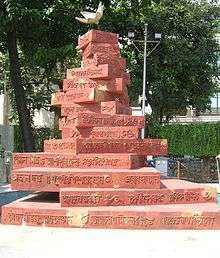Bengali literature
Bengali literature (Bengali: বাংলা সাহিত্য, romanized: Bangla Shahitto) denotes the body of writings in the Bengali language. Bengali has developed over the course of roughly 1,300 years. The earliest extant work in Bengali literature is the Charyapada, a collection of Buddhist mystic songs dating back to the 10th and 11th centuries, and considered to be written in an ancestor language of Bengali, Assamese, Odia and many other languages belonging to the Eastern branch of the Indo-Aryan languages. The timeline of Bengali literature is divided into three periods − ancient (650-1200), medieval (1200-1800) and modern (after 1800). Medieval Bengali literature consists of various poetic genres, including Hindu religious scriptures (e.g. Mangalkavya), Islamic epics (e.g. works of Syed Sultan and Abdul Hakim), Vaishnava texts (e.g. biographies of Chaitanya Mahaprabhu), translations of Arabic, Persian and Sanskrit texts, and secular texts by Muslim poets (e.g. works of Alaol). Novels were introduced in the mid-19th century. Other than the Eastern Nagari script, Bengali has been written with different scripts such as the Perso-Arabic and Sylheti Nagri in certain parts of history.[1] Nobel Laureate Rabindranath Tagore was the best known figure of Bengali literature to the world. Kazi Nazrul Islam, notable for his activism and anti-British literature, was described as the Rebel Poet and is now recognised as the National poet of Bangladesh.
| Bengali literature বাংলা সাহিত্য | |
|---|---|
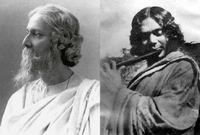 | |
| Bengali literature | |
| By category Bengali language | |
| Bengali language authors | |
| Chronological list – Alphabetic List | |
| Bengali writers | |
| Writers – Novelists – Poets | |
| Forms | |
| Novel – Poetry – Science Fiction | |
| Institutions and awards | |
| Literary Institutions Literary Prizes | |
| Related Portals Literature Portal India Portal | |
| Medieval and Renaissance literature |
|---|
| Early medieval |
| Medieval |
|
By century |
| European Renaissance |
|
|
Ancient (c. 650-1200)
The first works in Bengali, appeared between 10th and 12th centuries C.E.[2] It is generally known as the Charyapada and are 47 mystic hymns composed by various Buddhist monks, namely; Luipada, Kanhapada, Kukkuripada, Chatilpada, Bhusukupada, Kamlipada, Dhendhanpada, Shantipada and Shabarapada amongst others. The manuscript was discovered on a palm leaf in the Nepal Royal Court Library in 1907 by the Bengali linguist Haraprasad Shastri. Due to the language of these manuscripts only being partially understood, they were classified by Shastri with the name Sandhya Bhasha (সন্ধ্যা ভাষা), meaning dusk language.
Medieval (1200-1800)
Early medieval/Transitional (1200-1350)
This period is considered to be the time in which many common proverbs and rhymes first emerged. The Bengali alphabet became a lot like what it currently is. Ramai Pandit and Halayudh Misra were notable writers of this period.[3]
Pre-Chaitanya (1350-1500)
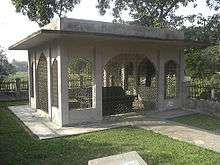
The Pre-Chaitanya period denotes the literature of the time preceding the period of Krishna Chaitanya, the founder of the Gaudiya Vaishanvite revivalist movement. During this period, Bengal was unified as a single region under the rule of independent Muslim Sultans introducing a new socio-political, ethnic and linguistic identity. Prominent genres which developed are Vaishnavite and Mangala writings amongst the Bengali Hindus, romantic and narrative epics amongst the Bengali Muslims, and translations of Arabic, Persian and Sanskrit works amongst both dominant religious groups. The Sultans of Bengal nurtured and patronised literature in the Bengali language, promoting harmony and a sense of egalitarianism in the country.
Muslim writers were exploring different themes through narratives and epics such as religion, culture, cosmology, love and history; often taking inspiration from or translating Arabic and Persian literary works such as the Thousand and One Nights and the Shahnameh.[4] The literary romantic tradition saw poems by Shah Muhammad Sagir on Yusuf and Zulaikha, as well as works of Sabirid Khan. The Dobhashi culture introduced Arabic and Persian vocabulary into Bengali texts to illustrate Muslim stories. Epic poetry included Nabibangsha by Syed Sultan, Janganama by Abdul Hakim and Rasul Bijoy by Shah Barid.[5]
Chandidas was the celebrated Hindu lyrical poet of this period, famed for translating Jayadeva's work from Sanskrit to Bengali and for producing thousands of poems dedicated to the love between Radha and Krishna such as the Shreekrishna Kirtana. Majority of Hindu writers in this period drew inspiration from a popular Maithili language Vaishnavite poet known as Vidyapati. Maladhar Basu's Sri Krishna Vijaya, which is chiefly a translation of the 10th and 11th cantos of the Bhagavata Purana, is the earliest Bengali narrative poem that can be assigned to a definite date.[6] Composed between 1473 and 1480 C.E., it is also the oldest Bengali narrative poem of the Krishna legend.[7][6] The Ramayana, under the title of Sri Rama Panchali, was translated by Krittibas Ojha.[8][8]
Chaitanya era (1500-1700)
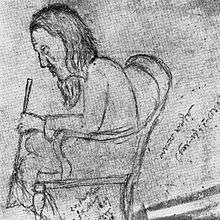
Chaitanya and post-Chaitanya literature denotes the literature during and succeeding the time of Krishna Chaitanya, the founder of the Gaudiya Vaishanvite revivalist movement who inspired his followers to write biographies of him which continued to last for decades after his death. Major figures of this period are Krishnadasa Kaviraja, Vrindavana Dasa Thakura, Jayananda, Govindadasa, Jnandada and Balaram Dasa amongst others. Mangal-Kāvya, a group of Hindu narrative poetry, eulogise the indigenous deities of rural Bengal in the social scenario. Mansa Mangal, Chandi Mangal and Dhormo Mangal, the three major genus of Mangal-Kāvya tradition include the portrayal of the magnitude of Manasā, Chandī and Dharmathakur, who are considered the greatest among all the native Hindu divinities in Bengal. Major poets of Mangalkavya tradition are Mukundram Chakrabarty, Bijay Gupta and Rupram Chakrabarty.
Bengali literature flourished in Arakan following its reconquest. It was home to prominent writers patronised in the Arakan royal court such as Alaol, who wrote Padmavati, as well as Daulat Qazi, Dawlat Wazir Bahram Khan, Quraishi Magan Thakur who wrote Chandravati and Maradan who wrote Nasirnama. Qazi was the first poet under the court patronage. He started writing Satimayna O Lorchandrani, considered to be the first Bengali romance. Teamwork was common in the court, and Alaol finished off Qazi's romance as the latter had died before managing to complete it.[14]
Late medieval (1700-1800)
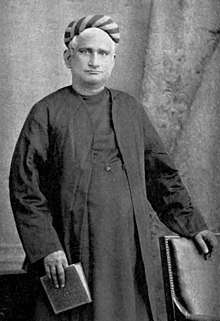
The arrival of European powers to Bengal led to a decline in flourishing Bengali literature. Padavalis and Mangala literature continued being produced although they were criticised for lacking meaning and focusing on rhythm instead.[3] Prominent writers included Bharatchandra Ray and Ramprasad Sen. Dinesh Chandra Sen and Chandra Kumar De were celebrated for their research on folklore, in particular the Mymensingh Gitika which was translated into English as the Eastern Bengal Ballads.
Modern (1800-present)
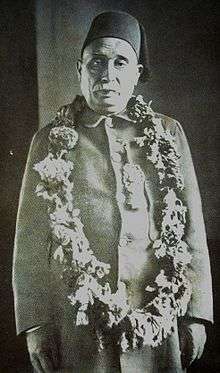
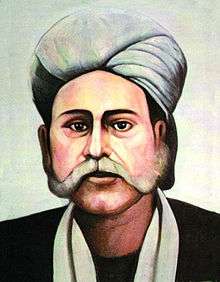
In the middle of 19th century, Bengali literature gained momentum. During this period, the Bengali Pandits of Fort William College did the tedious work of translating the text books in Bengali to help teach the British some Indian languages including Bengali. This work played a role in the background in the evolution of Bengali prose. In 1814, Raja Ram Mohan Roy arrived in Calcutta and engaged in literary pursuits. Translating from Sanskrit to Bengali, writing essays on religious topics and publishing magazines were some the areas he focussed on. He established a cultural group in the name of 'Atmiya Sabha' (Club of Kins) in 1815. Another significant contributor of Bengali literature in its early stage was Ishwar Chandra Bandyopadhyaya.
During and following the Indian rebellion of 1857, the literature of Bengal dramatically changed. In the light of the Indigo revolt in 1859, Nil Darpan (The Indigo Mirror) was published in Dhaka by Dinabandhu Mitra, and it played an important role in the development of Bengali theatre.
Michael Madhusudan Datta's first epic Tilottama Sambhab Kabya published in 1860 was the first Bengali poem written in blank verse. Bankim Chandra Chatterjee was considered one of the leading Bengali novelists and essayists of the 19th century. He also wrote Vande Mataram, the national song of India, which appears in his novel Anandamath (1882).[15] In the 1880s, Chatterjee critically analysed Hindu scriptures such as the Bhagavad Gita as well as the problems of Krishnaism from a historical perspective in his Dharmatattva and Krishna Charitra.[15]
Bengali literature has also produced many other notable talents. For example, famous and popular Bengali poets include Ishwar Chandra Gupta, Biharilal Chakraborty and Kaykobad. Romesh Chunder Dutt and Mir Mosharraf Hossain are notable for their works of fiction. Girish Chandra Ghosh and Dwijendralal Ray were prominent playwrights of the time, whereas Akshay Kumar Boral and Ramendra Sundar Tribedi are famous for their influential essays. Rassundari Devi authored the first full-fledged autobiography in modern Bengali literature in 1876.[16]
This era also saw a rise in new literary publications, magazines and newspapers. A number of educational institutes also appeared all over the region. Both these developments helped to nurture and advance the modern Bengali literary movement.
The Pre-Tagore era also saw an undercurrent of popular literature which was focused on daily life in contemporary Bengal. The prose style, as well as the humour in these works, were often crass, blunt and accessible. A masterpiece in this regard was "Hutom Pechar Naksha" (The Sketch of the Owl) written by Kaliprasanna Singha, and satirically depicts "Babu" culture in 19th century Kolkata. Other notable works in this regard are "Alaler Ghorer Dulal" (The Spoilt Brat) by Peary Chand Mitra, "Ramtanu Lahiri o tatkalin Banga shamaj" (Ramtanu Lahiri & contemporary Bengali society) by Nyaymohan Tarkalankar, and "Naba Babu Bilas" & "Naba Bibi Bilas" by Bhabanicharan Bandopadhyay. These books arguably portrayed contemporary Bengali dialect and popular society effectively, and also incorporated now-extinct music genres such as Khisti, Kheur and Kabiyal gaan by stalwarts like Rupchand Pakhi and Bhola Moyra. Books like these have become rarer since the emergence of Tagore culture, and the burgeoning preference for literary elegance and refinement in Bengali society.[17]
Nazrul and Tagore
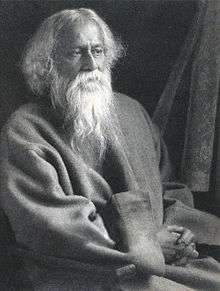
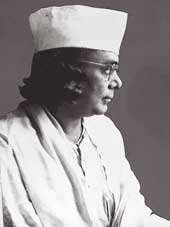
Rabindranath Tagore and Kazi Nazrul Islam are the most well-known prolific writers of Bengal in this century. Tagore is celebrated as the writer of both India's national anthem, Jana Gana Mana and Bangladesh's Amar Shonar Bangla as well as being a source of inspiration for the Sri Lanka Matha and similarly Nazrul is celebrated as the national poet of Bangladesh.[18][19][20]
Rabindranath Tagore dominated not only the Bengali, but also the Indian philosophical and literary scene as a whole for a number of decades. His 2,000 Rabindra Sangeets play a pivotal part in defining Bengali culture, both in West Bengal and Bangladesh. Other notable Bengali works of his are Gitanjali, a book of poems for which he was awarded the Nobel Prize for Literature in 1913, and many short stories and a few novels.
In the similar category is Kazi Nazrul Islam, who was invited to post-partition Bangladesh as the National Poet (he had been suffering from dementia and aphasia since 1942) and whose work transcends sectarian boundaries. Adored by Bengalis both in Bangladesh and West Bengal, his work includes 3,000 Nazrul Geetis. He is frequently called the "Rebel Poet" mainly because of his most famous and electrifying poem "Bidrohi" or "The Rebel", and also because of his strong sympathy and support for revolutionary activities leading to India's independence from British rule. His songs and poems were frequently used during the Bangladesh Liberation War as well. Though he is acknowledged as the rebel poet, Nazrul very effectively contributed in all branches of literature. He wrote poems that light the fire against inequality or injustice and at the same time is known for his poignant romantic poems as well. He was sent to jail for his literary works against the then prevailing British rule.
Other notable names
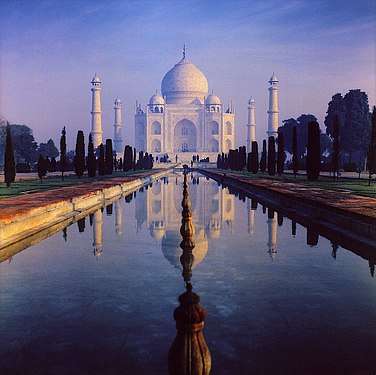 |
| Part of a series on |
| Islamic culture |
|---|
| Architecture |
| Art |
|
| Dress |
| Holidays |
|
| Literature |
|
| Music |
| Theatre |
|
Playwrights
Nurul Momen is recognized as the pioneer of modern Bengali drama, "acting as a bridge between earlier and later playwrights in terms of content and style", and even referred to as the "Father of Bangladeshi theatre".
Novelists
Sarat Chandra Chattopadhyay was one of the most popular novelists of early 20th century whose speciality was exploring the life and suffering of women in contemporary rural Bengal. His sympathy towards the common rural folks in "pallisamaj" and a trademark simplified Bengali as a writing style made him one of the most popular writers in his time. Even long after his death many Bengali and Bollywood blockbusters were based on his novels. After him Tarashankar Bandopadhyay, Bibhutibhushan Bandopadhyay and Manik Bandopadhyay were the three Bandopadhyays who broke out into a new era of realistic writing style. Where Bibhutibhusan and Manik had long standing influence on the two of the most brilliant film directors from Bengal, Satyajit Ray and Ritwik Ghatak respectively. Other famous Bengali novelists include Humayun Ahmed, Humayun Azad, Jagadish Gupta, Satinath Bhaduri, Balai Chand Mukhopadhyay (Banophool), Shawkat Osman, Saradindu Bandopadhyay, Kamal Kumar Majumdar, Sunil Gangopadhyay, Syed Shamsul Haque, Akhteruzzaman Elias, Sandipan Chattopadhyay, Bimal Mitra, Bimal Kar, Samaresh Basu, Mani Shankar Mukherjee (Shankar), Shyamal Gangapadhyay and Amar Mitra. Seeds of Bengali science fiction are evident in the writings of Jagadish Chandra Bose, which was later put into a definite genre by writers such as Jagadananda Roy, Begum Roquia Sakhawat Hussain, and Premendra Mitra, Satyajit Ray. Muhammed Zafar Iqbal and Abdullah-Al-Muti are also very popular in this genre.
Short story writers
Bengali literature is also famous for short stories. Some famous short story writers are Rabindranath Tagore, Manik Bandopadhyay, Jagadish Gupta, Tarashankar Bandopadhyay, Bibhutibhushan Bandopadhyay, Rajshekhar Basu (Parasuram), Syed Mujtaba Ali, Premendra Mitra,[21] Kamal Kumar Majumdar, Shibram Chakrabarti, Saradindu Bandopadhyay, Subodh Ghosh, Narendranath Mitra, Narayan Gangopadhyay, Satyajit Ray, Leela Majumdar, Shirshendu Mukhopadhyay, Ratan Lal Basu, Sandipan Chattopadhyay, Samir Roychoudhury, Subimal Basak, Basudeb Dasgupta, Subimal Mishra, Syed Waliullah, Amar Mitra, Shawkat Osman, Akhtaruzzaman Ilias, Hasan Azizul Huq, Shahidul Zahir, Jyotirindranath Nandi, Humayun Ahmed, Rashid Askari.
Poets
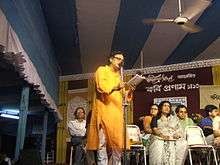
Rajanikanta Sen, Atulprasad Sen, Dwijendralal Ray, Jatindramohan Bagchi, Kumud Ranjan Mullick, Kazi Nazrul Islam, Jibanananda Das, along with Buddhadeva Bose, marks the beginning of the major move to transcend the Tagore legacy . Commonly called "polli-kobi" (pastoral poet) Jasimuddin, Shamsur Rahman, widely known for his 'playing with words' are also notable. Others are Al Mahmud, Abul Hasan and Abdul Mannan Syed.
Musicians
Seminal Hindu religious works in Bengali include the many songs of Ramprasad Sen. His works (still sung today) from the 17th century cover an astonishing range of emotional responses to the goddess Kali, detailing complex philosophical statements based on Vedanta teachings and more visceral pronouncements of his love of the goddess. They are known as Shyama Sangeet and were the literary inspiration for Kazi Nazrul Islam's later, famed Shyama Sangeet. There are also the laudatory accounts of the lives and teachings of the Vaishnava saint Chaitanya Mahaprabhu (the Choitanyo Choritāmrit) and Shri Ramakrishna (the Ramakrishna Kathamrita, translated roughly as Gospel of Ramakrishna). There is also a large body of Islamic literature, that can be traced back at least to Noornama by Abdul Hakim. Bishad Sindhu depicting the death of Hussain in Karbala is very popular novel written by Mir Mosharraf Hossain. Later works influenced by Islam include devotional songs written by Nazrul, and popularized by Abbas Uddin, among others.
Bauls and traditional singers
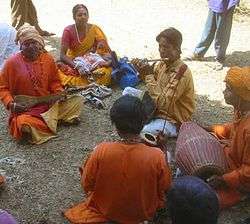
The mystic Bauls of the Bengal countryside who preached the boundless spiritual truth of Sôhoj Pôth (the Simple, Natural Path) and Moner Mānush (A person of The Heart) drew on Vedantic philosophy to propound transcendental truths in song format, traveling from village to village proclaiming that there was no such thing as Hindu, Muslim or Christian, only moner mānush.
The literature discussed so far can be more or less regarded as the common heritage of both Bangladesh and West Bengal. Since the partition of Bengal in 1947, the east and west parts of Bengal have also developed their own distinctive literatures. For example, the Naxalite movement has influenced much of West Bengal's literature, whereas the Liberation War has had a similarly profound impact on Bangladeshi literature.
Major literary figures in (East Bengal) Bangladesh
Nurul Momen, Syed Waliullah, Shahidullah Kaisar, Shawkat Osman, Ahsan Habib, Farrukh Ahmed, Syed Ali Ahsan, Syed Shamsul Haque, Abu Zafar Obaidullah, Sufia Kamal, Al Mahmud, Abubakar Siddique, Ghulam Murshid, Hasan Azizul Huq, Selina Hossain, Arunabh Sarkar, Shawkat Ali, Akhtaruzzaman Ilias, Rafiq Azad, Nirmalendu Goon, Taslima Nasrin, Abul Hasan, Abid Azad, Humayun Azad, Humayun Ahmed, Muhammed Zafar Iqbal, Hasan Hafizur Rahman, Shaheed Quaderi, Khondakar Ashraf Hossain, and Helal Hafiz to name a few.
West Bengal literature
Nihar Ranjan Gupta, Ashutosh Mukhopadhyay, Kamal Kumar Majumdar, Sunil Gangopadhyay, Nabaneeta Dev Sen, Syed Mustafa Siraj, Shirshendu Mukhopadhyay, Samaresh Basu, Atin Bandyopadhyay, Sandipan Chattopadhyay, Shakti Chattopadhyay, Mahasweta Devi, Moti Nandi, Bimal Kar, Narayan Gangopadhyay, Shankar, Suchitra Bhattacharya, Bani Basu, Buddhadeb Guha, Abdul Jabbar, Amar Mitra, Satyajit Ray and others.
1947-1965
| Part of a series on |
| Bengalis |
|---|
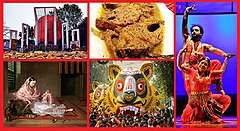 |
|
Bengali homeland |
|
Bengali culture
|
|
Bengali symbols |
Rajshekhar Basu (1880–1960) was the best-known writer of satiric short story in Bengali literature.[22] He mocked the charlatanism and vileness of various classes of the Bengali society in his stories written under the pseudonym "Parashuram".[22] His major works include: Gaddalika (1924), Kajjwali (1927), Hanumaner Swapna (1937), Gamanush Jatir Katha (1945), Dhusturimaya Ityadi Galpa (1952), Krishnakali Ittadi Galpa (1953), Niltara Ittadi Galpa (1956), Anandibai Ittadi Galpa (1958) and Chamatkumari Ittadi Galpa (1959). He received the Rabindra Puraskar, the highest literary award of Paschimbanga in 1955 for Krishnakali Ityadi Galpa.[23] Rajsheskhar was also a noted lexicographer, translator and essayist. His Chalantika (1937) is one of the most popular concise Bengali dictionaries, while his Bengali-language translations of Meghaduta (1943), the Ramayana (1946), the Mahabharata (1949) and the Bhagavat Gita (1961) are also acclaimed.[22] His major essays are included in Laghuguru (1939) and Bichinta (1955).[22]
Important novelists and short story writers of post-independence West Bengal are Jagadish Gupta (1886–1957), Tarasankar Bandyopadhyay (1889–1971), Bibhutibhushan Bandyopadhyay (1894–1950), Premendra Mitra (1904–1988), Manik Bandyopadhyay (1908–1956), Bibhutibhushan Mukhopadhyay (1894–1987), Sharadindu Bandyopadhyay (1899–1970), Achintya Kumar Sengupta (1903–1986), Annadashankar Roy (1904–2002), Buddhadeb Basu (1908–1974), Satinath Bhaduri (1906–1965), Narayan Gangopadhyay (1918–1970), and Subodh Ghosh (1900–1980). Noted poets of this age are Jibanananda Das (1899–1954), Sudhindranath Dutta (1901–1960), Bishnu Dey (1909–1982), Amiya Chakrabarty (1901–1986), Samar Sen (1916–1987), Subhas Mukhopadhyay (1919–2003) and Sukanta Bhattacharya (1926–1947). Major dramatists include: Sachin Sengupta (1892–1961) and Bidhayak Bhattacharya (1907–1986). Prominent prose-writers of this age are Suniti Kumar Chattopadhyay (1890–1977), Sukumar Sen (1900–1992), and Pramathanath Bishi (1901–1985).
Hungryalism
One of the path-breaking literary movements in West Bengal is known as The Hungry generation or Hungryalism. The famous poets of this movement are Malay Roy Choudhury, Shakti Chattopadhyay, Binoy Majumdar, Utpalkumar Basu Samir Roychoudhury, Falguni Roy, and Tridib Mitra. The fiction writers are Sandipan Chattopadhyay, Basudeb Dasgupta, Subimal Basak, Malay Roy Choudhury and Samir Roychoudhury. The painters are Anil Karanjai and Karunanidhan Mukhopadhyay. In 2011 director Srijit Mukherji incorporated the Hungry generation movement into mainstream cinema when he directed Baishe Srabon wherein famous film director Gautam Ghose portrayed the role of an anti-establishment Hungryalist poet. Mrigankashekhar Ganguly directed and produced a short film based on Malay Roy Choudhurys poem Stark Electric Jesus.
Prakalpana Movement
Prakalpana Movement, branded by Steve LeBlanc, the noted US critic, as 'a tiny literary revolution', 'nurtured' by Kolkata, has been fostering its new genres of Prakalpana fiction, Sarbangin poetry and Chetanavyasism for over four decades, spearheaded by Vattacharja Chandan, beginning in 1969. It is probably the only bilingual (Bengali -English) literary movement in India mothered by Bengali literature, that has spread its wings worldwide through the participation of well known international avant-garde writers and mail artists such as Richard Kostelanetz, John M. Bennett, Sheila Murphy, Don Webb, with notable Bengali poets, writers and artists like Vattacharja Chandan.[24]
See also
References
- Mohammad Daniul Huq & Pabitra Sarkar (2012). "Bangla Language". In Islam, Sirajul; Miah, Sajahan; Khanam, Mahfuza; Ahmed, Sabbir (eds.). Banglapedia: the National Encyclopedia of Bangladesh (Online ed.). Dhaka, Bangladesh: Banglapedia Trust, Asiatic Society of Bangladesh. ISBN 984-32-0576-6. OCLC 52727562. Retrieved 26 June 2020.
- Sen, Sukumar (1979) [1960]. History of Bengali (3rd ed.). New Delhi: Sahitya Akademi. p. 24. ISBN 81-7201-107-5.
- Mohammad Daniul Haq & Aminur Rahman (2012). "Bangla Literature". In Islam, Sirajul; Miah, Sajahan; Khanam, Mahfuza; Ahmed, Sabbir (eds.). Banglapedia: the National Encyclopedia of Bangladesh (Online ed.). Dhaka, Bangladesh: Banglapedia Trust, Asiatic Society of Bangladesh. ISBN 984-32-0576-6. OCLC 52727562. Retrieved 26 June 2020.
- "The development of Bengali literature during Muslim rule" (PDF). Archived (PDF) from the original on 9 August 2017. Retrieved 22 September 2017.
- "Sufi Literature". Banglapedia. Archived from the original on 11 September 2016.
- Sen, Sukumar (1979) [1960]. History of Bengali (3rd ed.). New Delhi: Sahitya Akademi. pp. 65–66. ISBN 81-7201-107-5.
- Ahmed, Wakil (2012). "Maladhar Basu". In Islam, Sirajul; Jamal, Ahmed A. (eds.). Banglapedia: National Encyclopedia of Bangladesh (Second ed.). Asiatic Society of Bangladesh.
- Sen, Sukumar (1991, reprint 2007). Bangala Sahityer Itihas, Vol.I, (in Bengali), Kolkata: Ananda Publishers, ISBN 81-7066-966-9, pp.105-10
- Caudhurī, Ābadula Āhasāna (1992). Lālana Śāha, 1774 - 1890 (1. punarmudraṇa. ed.). Ḍhākā: Bāṃlā Ekāḍemī. ISBN 978-9840725977. OCLC 246442470.
- Urban, Hugh B. (2001). Songs of ecstasy tantric and devotional songs from colonial Bengal. New York: Oxford University Press. p. 18. ISBN 978-0-19-513901-3. Retrieved 30 June 2015.
- Tagore, Rabindranath; K. Stewart, Tony (Translation); Twichell, Chase (Translation) (2003). The lover of God. Port Townsend, Wash.: Consortium Book Sales & Dist. p. 94. ISBN 978-1556591969.
- Hossain, Abu Ishahaq (2009). Lalon Shah, the great poet. Dhaka: Palal Prokashoni. p. 148. ISBN 978-9846030679. Retrieved 30 June 2015.
- Ginsberg, Allen; Foley, Jack (Winter–Spring 1998). "Same Multiple Identity: An Interview with Allen Ginsberg". Discourse. 20 (1/2, The Silent Beat): 158–181. ISSN 1522-5321. JSTOR 41389881.
- Sen, Sukumar (1993). Islami Bangla Sahitya (in Bengali), Kolkata: Ananda Publishers, ISBN 81-7215-301-5, pp.23-33
- Sen, Sukumar (1979) [1960]. History of Bengali (3rd ed.). New Delhi: Sahitya Akademi. pp. 211–12. ISBN 81-7201-107-5.
- Deepa Bandopadhyay. "নারীর লেখা নারীর কথা". Archived from the original on 19 May 2015.
- "Archived copy" (PDF). Archived from the original (PDF) on 5 July 2010. Retrieved 16 March 2010.CS1 maint: archived copy as title (link)
- de Silva, K. M.; Wriggins, Howard (1988). J. R. Jayewardene of Sri Lanka: a Political Biography – Volume One: The First Fifty Years. University of Hawaii Press. p. 368. ISBN 0-8248-1183-6.
- "Man of the series: Nobel laureate Tagore". The Times of India. Times News Network. 3 April 2011.
- "How Tagore inspired Sri Lanka's national anthem". IBN Live. 8 May 2012.
- "Mosquito and Other Stories by Premendra Mitra". Purple Pencil Project. 4 March 2019. Retrieved 9 June 2020.
- Das, Sisir Kumar, ed. (2003). Samsad Bangla Sahityasangi [Samsad Companion to Bengali Literature] (in Bengali) (1st ed.). Kolkata: Sahitya Samsad. p. 189. ISBN 81-7955-007-9.
- Adhya, Hemanta Kumar (2001). Rajshekhar Basu. Bharatiya Sahityakar Pustakmala (in Bengali) (1st ed.). Kolkata: Sahitya Akademi. 41-45.
- Songs of Kobisena by Steve Leblanc in Version 90, PMS Cafe Press, Alston, MS, USA.
External links
| Wikimedia Commons has media related to Bengali literature. |
- Library of Congress - Bengali Section
- Bengali Literature Archive
- Bangla News
- Influence of Baudelaire on Bengali Poetry baudelaireetbengale.blogspot.com
- An English Magazine on Bengali literature edited by Sayeed Abubakar
